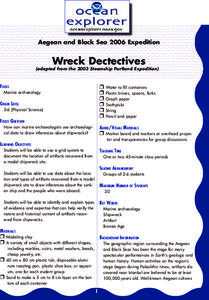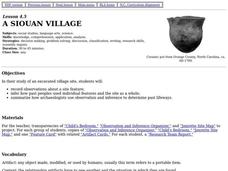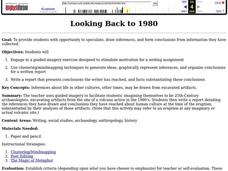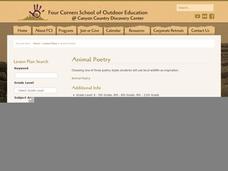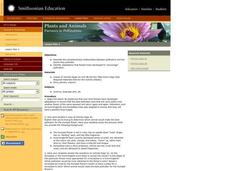Curated OER
Culture Everywhere
Students study their culture while filling in a chart that shows how culture meets basic human needs. They examine the role of archaeologists in studying people from past cultures.
Channel Islands Film
Cache: Lesson Plan 3 - Grades 4-5
Should the excavation of what is believed to be the cave of the Lone Woman of San Nicholas Island be allowed to continue? As a practice exercise designed to prepare pupils for a timed writing exam, individuals read two Los Angeles...
Channel Islands Film
Sa Hi Pa Ca (Once Upon a Time): Lesson Plan 2
What tools do archaeologists and anthropologist use to learned about what life was like in the past. After watching West of The West's documentary Once Upon a Time that details how scientists use artifacts to establish a...
Curated OER
Wreck Detectives
Junior archaeologists examine types of artifacts from the Bronze Age on the internet. In collaborative groups, they create a story about a ship from this period and then construct a model of the ocean floor after their ship has sunk....
Curated OER
A Siouan Village
Fourth graders examine the artifacts obtained from an excavated Siouan village site. They make inferences about the people who once lived there based on the artifacts and complete a Research Team Report.
Channel Islands Film
Cache: Lesson Plan 2 - Grades 4-6
Class members will dig this activity that has them trying their hand at recovering artifacts. Groups are assigned a section of a sandbox, carefully uncover the artifacts in their section, and then develop theories about who might...
Curated OER
Interpreting the Evidence
Students find out about the social changes that caused the collapse of important ancient civilizations in Central America, Mesopotamia, the southwestern United States, and western Africa.
Curated OER
Lesson plan: History Underfoot
Students study Native Americans of Virginia. In this Virginia history lesson, students take on the role of archaeologists as they analyze a site and its artifacts. Students use the information to draw conclusions about the natives who...
Curated OER
Forensics: Who Killed the Iceman?
Students explore how archaeologist examine mummies. In this research based lesson, students work in groups to research two mummies and report their findings to the class through role-playing and using a model of the mummy.
Curated OER
How To Think Like An Archaeologist
Students take a field trip to historical Jamestown. Using artifacts given to them, they must identify them and discover who would have used them and for what purpose. They create a database to organize the information and share it with...
Curated OER
Understanding Artifacts
Students will develop a greater awareness of the things surrounding them and will be able to build a bridge between their own material culture and that of an imaginary figure from the past. This activity focuses on the significance of...
Curated OER
People of the Past
Students investigate the four groups of people that existed in the U.S. before the European settlers arrived. They predict how the people arrived in the U.S., then investigate their predictions to find out whether or not they are...
Curated OER
The Dawn of Humanity
Young scholars investigate recent archaeological challenges to theories of human origins. They research the history and geography of various African regions to create proposals for future excavations.
Curated OER
Ceramics: A Vessel Into History
Students review a previous ceramics lesson and journal about a personal clay vessel they will create. In this ceramics lesson, students recognize various ceramic forms created in different time periods and...
Channel Islands Film
Cache: Lesson Plan 1 - Grades 9-12
Archaeologists have discovered a cache of Native American relics. They want to preserve these relics by removing them from the rapidly eroding site to a lab where they can be studied. Native American traditions demand that the items...
Curated OER
Indians in Georgia: How Do We Know What We Know?
Students discover archaeology by investigating the history of Native Americans in Georgia. In this U.S. history lesson, students participate in a mock archaeological excavation in their classroom by recovering artifacts and...
Curated OER
The Anasazi
Sixth graders investigate and determine the origins of the ancient Anasazi who inhabited present-day Utah and the Four-Corners-Region, after receiving direct instruction and carrying out activities in cooperative group settings. They...
Curated OER
Daily Life in Ancient Egypt
Students explain how artwork can inform about a culture and its traditions. They pretend to be archaeologists who have just opened a tomb. They interpret the past based on what they discover.
Curated OER
Inventions over Time
Sixth graders examine inventions, such as spear points and bows and arrows, and discuss their importance in human cultural development. They compare these early inventions with modern ones and determine the impact of science and...
Curated OER
Looking Back to 1980
Students use clustering/mind mapping techniques to generate ideas, graphically represent inferences, organize their conclusions and write a report that presents conclusions the writer has reached, and facts substantiating those conclusions.
Curated OER
Vocabulary Charts
Seventh graders are introduced to the vocabulary associated with archeology. Using a dictionary, they practice finding the meaning of various words and create sentences. They also identify an appropriate use of the word and draw an...
Curated OER
Animal Poetry
Fourth graders write poems that use local wildlife as their inspiration. After a class discussion which produces a list of wildlife that pupils have seen in their town, a review of three types of poetry ensues. They look at how...
Curated OER
Plants and Animals: Partners in Pollination
Students describe the complementary relationships between pollinators and the plants they pollinate, identify adaptations that flowers have developed to "encourage" pollination, and create and draw their own "designer" flowers.
Curated OER
Ancient Cultures
Students develop archeological skills in order to explain how scientists determine what ancient cultures were like. They develop an appreciation of the work that is involved in finding out about our past.



